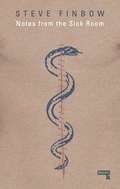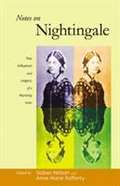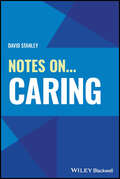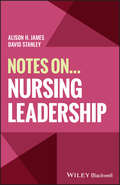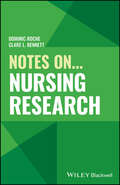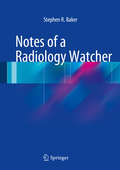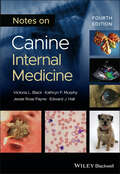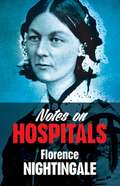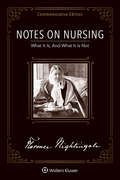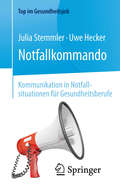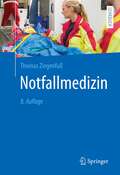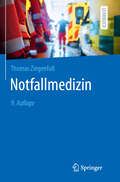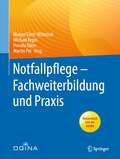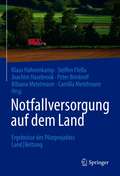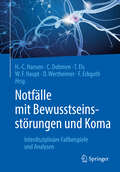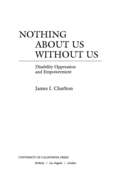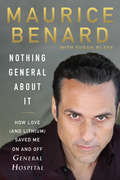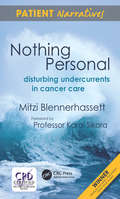- Table View
- List View
Notes From the Sick Room
by Steve FinbowNotes from the Sick Room is an investigation into the connections between physical illness and creativity. Although there are a number of books investigating mental illness and creativity, there are very few that concentrate on physical illness - cancer, HIV, tuberculosis and disabilities caused by accidents. Incapacity provides time for contemplation and creativity yet pain and discomfort detract from inspiration. Serious illness confronts the individual with the reality of death, the complacency of being is jolted by the shock of non-being. Does one record these incidences or ignore "art" in order to survive?
Notes On Nightingale
by Sioban Nelson Anne Marie RaffertyFlorence Nightingale remains an inspiration to nurses around the world for her pioneering work treating wounded British soldiers during the Crimean War; authorship of Notes on Nursing, the foundational text for nursing practice; establishment of the world's first nursing school; and advocacy for the hygienic treatment of patients and sanitary design of hospitals. In Notes on Nightingale, nursing historians and scholars offer their valuable reflections on Nightingale and analysis of her role in the profession a century after her death on 13 August 1910 and 150 years since the Nightingale School of Nursing (now the Florence Nightingale School of Nursing and Midwifery at King's College, London) opened its doors to probationers at St Thomas' Hospital. There is a great deal of controversy about Nightingale-opinions about her life and work range from blind worship to blanket denunciation. The question of Nightingale and her place in nursing history and in contemporary nursing discourse is a topic of continuing interest for nursing students, teachers, and professional associations. This book offers new scholarship on Nightingale's work in the Crimea and the British colonies and her connection to the emerging science of statistics, as well as valuable reevaluations of her evolving legacy and the surrounding myths, symbolism, and misconceptions.
Notes On... Caring (Notes On (Nursing))
by David StanleyNOTES ON… CARING Discover the connection between care and healing with this transformative book Care is often regarded as fundamental to the nursing profession, almost synonymous. The relationship between care and nursing is presented as though no further explanation is required, no theorisation of what it means to care, and no elaboration of the role played by care in nursing as a profession and a practice. Given the agreed-upon centrality of care to nursing, there is an urgent need for a work analysing this key relationship and what it can mean for nursing professionals. Notes On… Caring meets this need with a clear, concise discussion of caring in the healthcare context. Beginning from the premise that care is essential to fostering the health and healing of others, it sets out to clarify the subject and articulate an ethic of care that can be cultivated in nursing and medical practice. With the COVID-19 pandemic placing nursing care more than ever at the forefront of public health, there has never been a better time to understand what it means for nurses to care. This book is ideal for all nurses, midwives, and other medical professionals or students.
Notes On... Nursing Leadership (Notes On (Nursing))
by David Stanley Alison H. JamesNOTES ON... NURSING LEADERSHIP Unlock the secrets to effective nursing leadership with this essential guide In the ever-evolving landscape of healthcare, leadership capability is a vital skill for nurses, however, leadership development and application within the field is rarely addressed during training. This essential resource ensures nurses are equipped with the guidance needed to develop as effective and resilient leaders within the workplace. Centred on the clinical nurse’s perspective, this text serves as a practical guide to applying nursing leadership concepts and provides a timely and authoritative overview of what it means to be a nurse leader in the health service. Throughout the text, the authors provide vignettes that share their personal experiences, highlight the value of applying nursing leadership, describe the different components of leadership, and more. Notes On... Nursing Leadership is a must-read for undergraduate and trainee nurses looking for a concise introductory text that links current key debates and thinking in leadership to nursing practice. It is also an invaluable resource for qualified and practicing nurses wanting to develop their leadership skills, broaden their leadership potential, or inspire and support other nurses in their approach to leadership.
Notes On... Nursing Research (Notes On (Nursing))
by Clare L. Bennett Dominic RocheGenerate and apply high-quality research in a nursing context with this accessible guide The production and application of rigorous, effective research can have a significant impact on nursing care. Notes On… Nursing Research offers an overview of nursing research, its relationship with clinical practice and patient outcomes, and its positive effects on the nursing professional. Beginning with an introduction to the fundamental principles of nursing research, it moves through the stages of designing and conducting research studies before concluding with specific applications of research to clinical practice and patient care. Notes On… Nursing Research readers will also find: A step-by-step guide to formulating and answering a research question Detailed discussion of research methodologies including data collection and analysis, inferential statistics, multivariate statistics, evidence synthesis, and much more Specific examples showing how research has improved patient care and outcomes Notes On… Nursing Research is ideal for undergraduate nurses, as well as a valuable resource for qualified and practicing nurses and other health professionals looking to develop their understanding of research.
Notes of a Radiology Watcher
by Stephen R. BakerThe Radiology Department is a pivotal part of any acute and/or comprehensive health care facility. The radiologist can no longer just "hide out" there. Matters of imaging are often public concerns, larger in scope than just the scheduling and managing of a series of image tests. Rather radiology is expensive, often intrusive and in some areas earnestly and endlessly controversial. A radiologist must be attuned to these often confounding contingencies. Two recent developments in the monitoring of education of radiologists can be impacted by the content of this book. For trainees in Radiology, and for that matter, for all trainees in every medical specialty in the U. S. , a new accreditation system (NAS) has been put into place under the impetus and aegis of the ACGME, the Accreditation Committee for Graduate Medical Education, the body responsible for graduate medical evaluation and oversight in the U. S. Among its many innovations, the NAS curriculum is concerned with knowledge acquired about social and economic issues pertinent to each specialty. It is also focused on improving communication skills and about enhancing quality and safety. In the elaboration of "milestones" for residency education in these issues are codified into focused initiatives that must be addressed by each trainee as he or she advances in capability and seniority within the training interval.
Notes on Canine Internal Medicine
by Victoria L. Black Kathryn F. Murphy Jessie Rose Payne Edward J. HallCanine Internal Medicine A thorough yet concise guide to diagnosing and managing canine medical conditions The newly revised Fourth Edition of Notes on Canine Internal Medicine delivers a comprehensive guide to the diagnosis of common and uncommon medical conditions in dogs. Written to act as a practical and fast-access subject reference for veterinary practitioners and students, Notes on Canine Internal Medicine encourages physicians to take a logical and evidence-based approach to canine medicine. Divided into five sections, the first four are dedicated to clinical presentations, physical and laboratory abnormalities, and – new to this edition – imaging patterns. It concludes with a section on the organ systems of canines, providing a robust summary of how to diagnose and manage common specific conditions of each system. This new edition includes: A thorough introduction to the clinical presentations of a variety of presenting complaints, with both common and uncommon causes of each complaint and a logical diagnostic approach In-depth examinations of common and uncommon physical problems, with a complete diagnostic approach including lab results and key imaging findings that aid in diagnosis Comprehensive explorations of laboratory abnormalities in haematology, serum biochemistry, and urinalysis Practical discussions of diagnostic imaging patterns, including plain radiographic, ultrasonographic, contrast radiographic, and cross-sectional imaging Notes on Canine Internal Medicine Fourth Edition is designed to be a useful resource for all veterinary clinicians; as a handy point of reference for veterinary students, recently graduated veterinary surgeons and those returning to work after career breaks, but also for experienced veterinary surgeons dealing with particularly difficult or challenging cases.
Notes on Feline Internal Medicine
by Kit SturgessHelping you get started with a problem solving approach to a sick cat. Notes on Feline Internal Medicine 2nd edition is part of a popular series specifically designed, through an accessible note-based style, to ensure veterinarians and students have quick and easy access to comprehensive and practical clinical and diagnostic information.Distinct differences exist between cats and dogs not only in their physiology and metabolism but also in the way disease tends to present. This book is a short 'pocket guide' to feline internal medicine helping you to formulate a diagnostic plan and therapeutic strategy. The focus is on evidence-based medicine where available, otherwise current best practice is presented.The book is divided into four sections:* Section 1 gives an overview of some key areas of feline medicine including paediatric and geriatric medicine.* Section 2 focuses on the approach to common presenting signs and differential diagnosis of commonly used haematologic and biochemical parameters.* Section 3 presents an organ system based approach* Section 4 covers feline infectious diseases.A selection of useful texts and websites for further reading are included at the end of the book.CHANGES FOR THIS EDITION* Stronger focus is placed on initial testing for a disease, and what changes might be expected.* Additional sections have been added on sedation and anaesthesia, health screening, oncology and emergency and critical care.* More diagrams added to aid understanding. * Care taken to avoid repetition and focus placed on common conditions.
Notes on Hospitals: Being Two Papers Read Before The National Association For The Promotion Of Social Science, At Liverpool, In October 1858
by Florence NightingaleThe founder of modern nursing expressed her revolutionary ideas of hospital reform in these two essays, published in 1859 and presented the previous year at the Social Science Congress. During the Crimean War, Florence Nightingale achieved renown as The Lady with the Lamp, the tireless caretaker of wounded soldiers. Afterward, Nightingale searched Europe for innovations to help the army improve its hospital care. This report of her findings and suggestions had a profound effect on the medical community and reestablished the author as an international healthcare authority.Despite the advances in medical knowledge since Nightingale's era, her common-sense approach continues to form a solid foundation for nursing. In these essays she voices the importance of hygiene―fresh air and water, cleanliness, proper drainage, and ample light―as well as ongoing consideration for patients' feelings. Nightingale's ability to effectively articulate her ideas impressed her contemporaries and continues to influence modern readers. This volume serves as a companion to Nightingale's classic of nursing literature, Notes on Nursing: What It Is, and What It Is Not.
Notes on Nursing: Commemorative Edition
by Florence NightingalePublisher's Note: Products purchased from 3rd Party sellers are not guaranteed by the Publisher for quality, authenticity, or access to any online entitlements included with the product. Be inspired by the timeless insights of the woman who created the foundations of modern nursing, with Florence Nightingale’s Notes On Nursing, the 160th Anniversary Edition. Supported by essays from modern-day nurses, this still-relevant work offers concise, on-the-ground experience and breakthrough insights into the crucial elements of patient care. Each chapter brings to life Nightingale’s determination to advance the healthcare system of her time, empowering modern nursing professionals, educators, and students of all levels to establish their own crucial findings and innovations.
Notes on Small Animal Dermatology (Notes On Ser.)
by Judith JoycePart of the popular ‘Notes On’ series, this book is full of practical advice and information on diagnosing and treating common dermatological problems in small animals. The rapid reference format is designed to help you locate information as quickly as possible. Information on common dermatological complaints is offered in different ways to meet a variety of needs. Firstly a problem-orientated perspective is provided, and then a disease-based perspective looking at what underlying problems cause particular diseases. This is followed by a section that looks at dermatological disease by anatomical location, and a section that outlines different treatments. •Supplemented with full-colour photographs throughout to aid diagnosis •Detailed flow-diagrams illustrate the problem-orientated approach •Text is laid out in note form for ease of reference This book is ideal for veterinary students, new practitioners and established professionals who need a quick refresher
Notfallkommando - Kommunikation im Notfall (Top im Gesundheitsjob)
by Uwe Hecker Julia WeißgerberIm Notfall klar und gut kommunizieren! Dieses Buch richtet sich an Pflegende, Ärzte, Rettungssanitäter und weitere Gesundheitsfachberufe, die in Notfallsituationen miteinander arbeiten und als Team schnelle und lebenswichtige Informationen austauschen müssen.
Notfallkommando - Kommunikation in Notfallsituationen für Gesundheitsberufe
by Julia Stemmler Uwe HeckerIm Notfall klar und gut kommunizieren!Dieses Buch richtet sich an Pflegende, Ärzte, Rettungssanitäter und weitere Gesundheitsfachberufe, die in Notfallsituationen miteinander arbeiten und als Team schnelle und lebenswichtige Informationen austauschen müssen.
Notfallkommando - Kommunikation in Notfallsituationen für Gesundheitsberufe (Top im Gesundheitsjob)
by Julia Stemmler Uwe HeckerIm Notfall klar und gut kommunizieren!Dieses Buch richtet sich an Pflegende, Ärzte, Rettungssanitäter und weitere Gesundheitsfachberufe, die in Notfallsituationen miteinander arbeiten und als Team schnelle und lebenswichtige Informationen austauschen müssen.
Notfallmedizin
by Thomas ZiegenfußDieses Lehrbuch bietet Ihnen einen vollständigen Überblick über alle prüfungsrelevanten Inhalte der Notfallmedizin. Es leitet Sie leicht verständlich von den Grundlagen bis zur Praxis durch das gesamte Wissen. Profitieren Sie von der langjährigen Erfahrung des Autors, der sorgfältig das Wesentliche für Sie ausgewählt und aufbereitet hat.Der InhaltDiese aktualisierte Neuauflage berücksichtigt die Leitlinien des European Resuscitation Council 2020. Zahlreiche Abbildungen und das bewährte didaktische Konzept ermöglichen ein effizientes Lernen:Prüfungsteil – Für eine optimale Vorbereitung auf FallstudienCave- und Merksätze – Bringen das Wichtigste auf den PunktPraxistipps – Stellen einen anschaulichen Bezug zur Notfallpraxis herDer AutorDr. Thomas Ziegenfuß ist Chefarzt der Abteilung für Anästhesie und Intensivmedizin des St. Josef-Krankenhauses in Moers. An der Klinik für Anästhesiologie und Intensivmedizin der Universitätskliniken des Saarlandes war er Oberarzt, langjähriger Einsatzleiter für den Notarztdienst und Leitender Notarzt.
Notfallmedizin
by Thomas ZiegenfußUp to Date in der Notfallmedizin! Dieses Lehrbuch bietet Ihnen einen vollständigen Überblick über alle prüfungsrelevanten Inhalte der Notfallmedizin. Es leitet Sie leicht verständlich von den Grundlagen bis zur Praxis durch das gesamte Wissen. Profitieren Sie von der langjährigen Erfahrung des Autors, der sorgfältig das Wesentliche für Sie ausgewählt und aufbereitet hat. Der Inhalt Diese aktualisierte Neuauflage berücksichtigt die Leitlinien des European Resuscitation Council 2020. Zahlreiche Abbildungen und das bewährte didaktische Konzept ermöglichen ein effizientes Lernen: Prüfungsteil – Für eine optimale Vorbereitung auf Fallstudien Cave- und Merksätze – Bringen das Wichtigste auf den Punkt Praxistipps – Stellen einen anschaulichen Bezug zur Notfallpraxis her Der Autor Dr. Thomas Ziegenfuß ist Chefarzt der Abteilung für Anästhesie und Intensivmedizin des St. Josef-Krankenhauses in Moers. An der Klinik für Anästhesiologie und Intensivmedizin der Universitätskliniken des Saarlandes war er Oberarzt, langjähriger Einsatzleiter für den Notarztdienst und Leitender Notarzt.
Notfallpflege - Fachweiterbildung und Praxis
by Margot Dietz-Wittstock Michael Kegel Procula Glien Martin PinKompetentes Handeln in Notfallsituationen! Dieses Grundlagenwerk bietet Pflegenden umfassendes Wissen für die gute Versorgung ihrer Patienten in der Notaufnahme und für die anspruchsvolle Fachweiterbildung. Notfallpflegende brauchen spezielle Kompetenzen, um im Spannungsfeld zwischen leichten und hoch akuten, komplexen und zeitkritischen Notfällen richtig handeln zu können. Neben der fachlichen Versorgung, geht es aber auch darum, den Nöten und Ängsten der einzelnen Menschen angemessen zu begegnen. Unerlässlich dabei ist die gelungene Zusammenarbeit im multiprofessionellen Team. Lernen Sie von den Experten und bleiben Sie motiviert für Ihre Arbeit in der Notfallversorgung!
Notfallsanitäter als neuer Beruf im Rettungsdienst: Ein Überblick über Entwicklungen und Tendenzen (essentials)
by Pierre PfütschPierre Pfütsch zeigt, dass mit dem Notfallsanitätergesetz aus dem Jahr 2014 die berufliche Tätigkeit im Rettungsdienst stark aufgewertet wurde. Den Berufsangehörigen wurde eine dreijährige Ausbildung, die Möglichkeit zur akademischen Bildung und sogar die Ausübung bestimmter heilkundlicher Maßnahmen zugestanden. Nach Ansicht des Autors wird seitdem die Frage nach Delegation bzw. Substitution ärztlicher Leistungen verhandelt. Zu Beginn waren Rettungssanitäter zum überwiegenden Teil ehrenamtliche Mitarbeiter, die kaum mehr als eine Erste-Hilfe-Ausbildung besaßen und lediglich für den Transport zuständig waren. Aufgrund des medizinischen Fortschritts und der steigenden Unfallzahlen im Straßenverkehr setzte Ende der 1960er-Jahre eine Professionalisierung dieses Berufsfeldes ein. Treffen Notfallsanitäter vor dem Notarzt am Unfallort ein und müssen bei lebensbedrohlichen Zuständen tätig werden, begeben sie sich in eine juristische Grauzone, die einige Unsicherheiten mit sich bringt.Der Autor: Dr. Pierre Pfütsch ist Historiker und wissenschaftlicher Mitarbeiter am Institut für Geschichte der Medizin der Robert Bosch Stiftung in Stuttgart und forscht dort zur deutsch-deutschen Zeitgeschichte von Gesundheitsberufen.
Notfallversorgung auf dem Land: Ergebnisse des Pilotprojektes Land|Rettung
by Joachim Hasebrook Steffen Fleßa Klaus Hahnenkamp Peter Brinkrolf Bibiana Metelmann Camilla MetelmannDie Notfallversorgung in ländlichen Gebieten ist gefährdet, da unter anderem die Anzahl der Notfälle steigt, komplexe Einsätze zunehmen und die Anzahl der Notärzte sinkt. Wie es dennoch gelingt, die Notfallversorgung aufrechtzuerhalten, ist Gegenstand des großen, vom Innovationsfond des Gemeinsamen Bundesausschuss geförderten Pilotprojekts „Land|Rettung“. Die wesentlichen Ergebnisse des Projekts sind in diesem Buch zusammengefasst. Das innovative Konzept beinhaltet vier Säulen: 1. Stärkung der Laienreanimation, 2. Smartphone-basierte Ersthelfer-Alarmierung, 3. Telenotarzt-System, 4. Zusammenarbeit von Rettungsdienst mit dem kassenärztlichen Notdienst. Das Buch zeigt Lösungen und Ergebnisse in Bezug auf medizinischen Nutzen, Wirtschaftlichkeit und Nachhaltigkeit. Es wendet sich an alle, die in der prähospitalen Akutmedizin tätig sind sowie an Entscheider in Gesundheitspolitik, Kommunalverbänden, Hilfsorganisationen und die Träger des Rettungsdienstes sowie an Entwickler von Produkten und Geräten für die Telemedizin.
Notfälle in der Orthopädie: Ein Handbuch für Studierende, Ärzte und Ärztinnen, Physician Assistants und Pflegefachkräfte
by John T. GorczycaDieses kompakte Handbuch bietet einen praxisnahen Überblick über häufige Notfälle in der Orthopädie und basiert auf Unterrichtsmaterial der Universität Rochester. Es richtet sich an medizinisches Fachpersonal ohne orthopädische Ausbildung, z.B. Medizinstudierende, Ärzt*innen aus nicht orthopädischen Fächern, Pflegefachkräften und Physician Assistants, und unterstützt sie bei der Beurteilung und Behandlung dieser Fälle. Oft genügt ein grundlegendes Verständnis der Verletzung und der Behandlungsprioritäten, um eine angemessene Sofortversorgung der Patienten zu ermöglichen, von der diese in hohem Maße profitieren. Mehr als ein Dutzend orthopädischer Notfälle werden in einem leicht verständlichen Format präsentiert, darunter offene Frakturen, Gelenkluxationen, septische Arthritis und das Kompartmentsyndrom. Jedes Kapitel beginnt mit einem klinischen Fallbeispiel und enthält dazu relevante Fragen sowie farbige Abbildungen. Ein ideales Nachschlagewerk für Medizinstudierende, nicht-orthopädische Ärzte, Pflegefachkräfte und Physician Assistants – Notfälle in der Orthopädie ist ein praxisorientierter Leitfaden für den Umgang mit diesen kritischen Situationen.
Notfälle mit Bewusstseinsstörungen und Koma: Interdisziplinäre Fallbeispiele und Analysen
by Hans-Christian Hansen Frank Erbguth Christian Dohmen Thomas Els Walter F. Haupt Daniel WertheimerAnhand von 36 realen Fällen mit akuter Störung des Bewusstseins aller Altersstufen schildert dieses Buch, wie Stufendiagnostik und Therapiemaßnahmen aufgebaut sind und wie sie sich im weiteren Behandlungsprozess ständig in kritischer Überprüfung befinden. Das Spektrum der zugrunde liegenden Hirnfunktionsstörungen umfasst neurologische, psychiatrische, internistische und unfallchirurgische Erkrankungen. Lehrreich sind sowohl die Kasuistiken mit günstigem Behandlungsergebnis als auch die Verläufe von Patienten, die ihre Erkrankung nicht überlebt hatten. Die Fallschilderung erfolgt systematisch und praxisorientiert nach Anamnese, Diagnostik und Befund, Therapie und Verlauf, Fazit und Tak-Home-Messages. Zielgruppen sind praktisch tätige Neurologen, Internisten, Intensivmediziner, Notfallmediziner und Psychiater.
Nothing About Us Without Us
by James I. CharltonJames Charlton has produced a ringing indictment of disability oppression, which, he says, is rooted in degradation, dependency, and powerlessness and is experienced in some form by five hundred million persons throughout the world who have physical, sensory, cognitive, or developmental disabilities. Nothing About Us Without Us is the first book in the literature on disability to provide a theoretical overview of disability oppression that shows its similarities to, and differences from, racism, sexism, and colonialism. Charlton's analysis is illuminated by interviews he conducted over a ten-year period with disability rights activists throughout the Third World, Europe, and the United States. Charlton finds an antidote for dependency and powerlessness in the resistance to disability oppression that is emerging worldwide. His interviews contain striking stories of self-reliance and empowerment evoking the new consciousness of disability rights activists. As a latecomer among the world's liberation movements, the disability rights movement will gain visibility and momentum from Charlton's elucidation of its history and its political philosophy of self-determination, which is captured in the title of his book. Nothing About Us Without Us expresses the conviction of people with disabilities that they know what is best for them. Charlton's combination of personal involvement and theoretical awareness assures greater understanding of the disability rights movement.
Nothing General About It: How Love (and Lithium) Saved Me On and Off General Hospital
by Maurice Benard Susan BlackThe General Hospital star recounts his emotional journey in this instant bestseller, a story of success, show business, family, and mental health.New York Times–bestselling author and Emmy Award–winning actor Maurice Benard is best known for his twenty-five years of playing Michael “Sonny” Corinthos, Jr., on ABC’s hit daytime television show General Hospital. The rakish mobster is beloved and feared, perhaps in equal measure, but what many viewers don’t know is that for decades, Benard lived in true fear of a much greater threat: himself.In Nothing General About It, Benard relays the challenges of growing up in a small town with undiagnosed bipolar disorder, and his struggle to keep his demons at bay while pursuing a career as an actor. From childhood to the outset of his career—and while building his family—he was pushed to the very boundaries of despair, struggling with the stigma of having a mental illness he felt he couldn’t share with the world. In his first memoir, Benard delves into the most challenging parts of his life, including his tenuous childhood relationship with his father, secretly managing manic episodes on the set of General Hospital, and fending off the terrifying setbacks he experienced when he went off his meds.An advocate for mental health awareness, Benard now uses his platform to show all those who are struggling that there is light to be found. Nothing General About It is more than a story of adversity—it’s a love story, a case study in perseverance and candor, and a reminder that bravery is achieved by embracing who you truly are.
Nothing Personal: Disturbing Undercurrents in Cancer Care (Radcliffe Ser.)
by Mitzi BlennerhassettThis is a remarkable book. It is the story of just one person but it is repeated time and time again by many, all over the world. She has a complex but potentially curable cancer from the outset - one that requires a surgical intervention, radiotherapy and chemotherapy to treat optimally. So Mitzi experiences everything. With a young and very active family to look after, she has a lot to live for so how she deals with uncertainty is fascinating. The disruption to her life by the cancer and its treatment is massive and to add to it all she is going through a marital breakdown at the same time.I feel it's an incredible privilege to be allowed to follow her journey so closely. 'This is essential reading for all who deal with cancer patients - health professionals, politicians, health service developers, carers and, of course, patients themselves. It clearly gives us a distillation of what cancer patients want. We need to create a new network of modern cancer centres where the latest technology in radiotherapy and chemotherapy is seamlessly delivered in a comfortable, welcoming environment. Novel information technology can be used to link the centres so every patient will be monitored to get the best possible treatment.'
